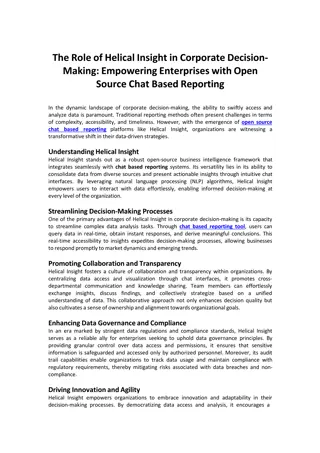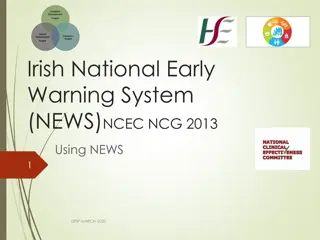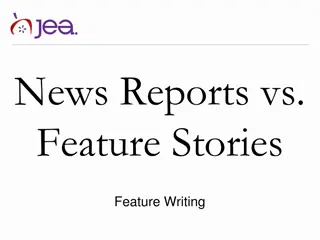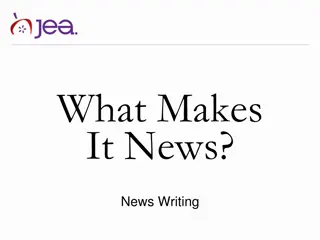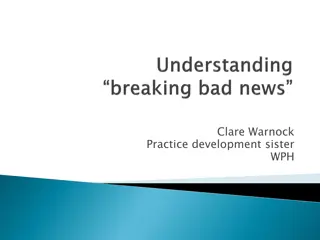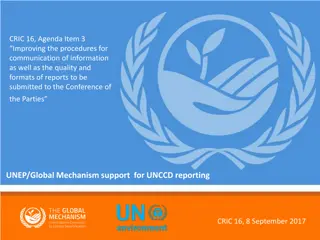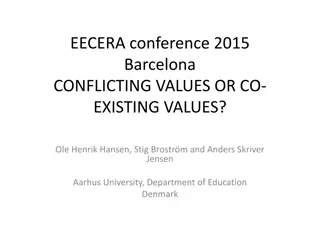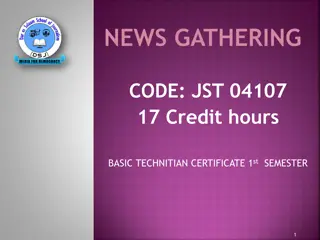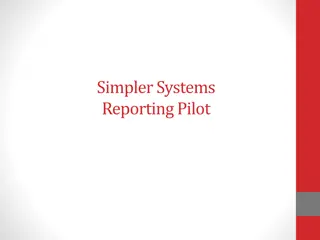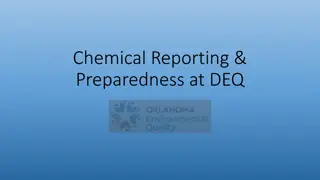Understanding the Elements of News Values and Timeliness in Reporting
News can be defined as an accurate, unbiased account of timely happenings that interest readers. The main determinant of news is interest, which is influenced by values like timeliness and proximity. Understanding these elements helps in delivering impactful and relevant news stories to the audience.
Download Presentation

Please find below an Image/Link to download the presentation.
The content on the website is provided AS IS for your information and personal use only. It may not be sold, licensed, or shared on other websites without obtaining consent from the author. Download presentation by click this link. If you encounter any issues during the download, it is possible that the publisher has removed the file from their server.
E N D
Presentation Transcript
DEFINITIONS OF NEWS William S. Maulsbyl defined news thus: News is an accurate, unbiased account of the significant facts of a timely happening that is of interest to the readers of the newspaper that prints the account. William G. Bleyer defines it like this: News is anything timely that interests a number of people; and the best news is that which has the greatest interest for the greatest number.
Elements of News Values While definitions of news vary, the main determinant of what can be considered as news is INTEREST. To be news, an account of an event must be of interest to the readers, listeners or viewers. Interest in a story is determined by the news values.
Timeliness Today s news may be stale tomorrow. Therefore, to attain that reader viewer or listener interest or appeal, facts must be fresh. However, some issues of great impact are timeliness. Therefore, the best time to tell an important story is as soon as it happens or as soon as possible.
There are two types of proximity: Proximity/Geographic Location Distance between the news item s place of origin and its place of publication determines its degree of reader appeal, and the limits of reader interest. Usually, the nearer an individual is to the location of a news event, the more relevant it becomes for him/her. This is referred to as geographic proximity. An account of robbery in Defense (DHA) will definitely interest residents in areas nearby than someone in Karachi. This is referred to as proximity of interest.
Proximity of Interest A story of epidemic affecting people s lives in another country may also interest us due to proximity of interest. Similarly if there s a news about something that interests us regardless of nearness in geography, it would still have news value. Prominence/Personality Involved All men may be created equal, but some are more equal and more newsworthy than others. In fact, names make news goes a clich . However, names do not always make news. Still, happenings that involve well-known people or institutions are likely to be interesting even if not very important.
Consequence/Impact/Magnitude How many people an event or idea affects and how seriously it affects them determine its importance as news, as well as the extent to which the information may be useful. Again, an item or event may give rise to thought not because of itself but because of its probable consequences its significance.
Human Interest Interest in human beings and events because they concern men and women in situations that might confront anyone else, is called human interest. In a general way, human- interest stories might be defined as those stories that arouse an emotion in the reader/ listener/ viewer and evoke emotional response.
Novelty This sounds like human interest but shows some differences. The unusual makes news. The bizarre makes news too. Remember the-man bite- dog principle. The principle applies here. The first flight to the moon was big news.The day a female becomes the Vice President of the US it will be the biggest news around the globe. Firsts, Lasts, and Only have always been newsworthy. So also are stories of freak occurrences and scientific or pseudoscientific phenomena.
. Conflict Nearly every story on each of our front pages is a report of conflict. Conflict is a central feature of most news. Sometimes it is physical, as in wars or sports. Sometimes it is more subtle and sophisticated like political conflicts. Necessity The seven earlier discussed news values involve people, events and situations that call out for coverage. The value of necessity is, however, the journalist s making (Mencher, 2010). According to the Mencher (2010), the journalist has discovered something he or she feels it is necessary to disclose. The essential element here is that the journalist considers a situation to be something everyone should know about and usually it is a situation that needs to be exposed and remedied.
News Virtues Now that what news is and what determines readers interest in a story have been discussed, reporters should strive to make the news they publish or broadcast win the credibility and confidence of their readers and listeners by adhering firmly to the triple news virtues. These triple news virtues are:
Truth All news stories must represent factual events and personalities. The reporter should also ensure that the facts of the News are truthful to the best of his/her knowledge before publishing or broadcasting such story.
Objectivity Objectivity presupposes that the reporter presents the reader with all sides of an issue, presents all the facts and allows the reader to decide what these facts mean. For a story to be objective, it must be devoid of a reporter s biases and prejudice. It must not also be slanted or editorialised.
Accuracy This is the last news virtue. Accuracy is a pillar on which every story rests. A news story can be regarded as accurate if all names, ages, addresses and direct quotations in the story are accurate or correct. The only way to meet this requirement is for the reporter to check, doublecheck or even triple-check his facts before going to the press.




